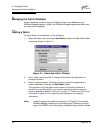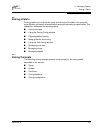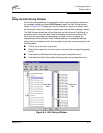
3 – Managing Fabrics
Zoning a Fabric
3-10 59022-03 D
3.4.1.1
Zones
A zone is a named group of ports or devices that can communicate with each
other. Membership in a zone can be defined by port number, device Fibre
Channel address, or device World Wide Name (WWN). Zone members can
communicate only with members of the same zone. Zones can overlap; that is, a
port or device can be a member of more than one zone.
Three types of zones are supported. The following zone types define increasing
restrictive levels of communication.
■ Soft zone
■ Access Control List (ACL) - hard zone
■ Virtual Private Fabric (VPF) - hard zone
3.4.1.1.1
Soft Zones
Soft zoning divides the fabric for purposes of controlling discovery. Members of
the same soft zone automatically discover and communicate freely with all other
members of the same zone. The soft zone boundary is not secure; traffic across
soft zones can occur if addressed correctly. Soft zones that include members from
multiple switches need not include the ports of the inter-switch links. Soft zone
boundaries yield to ACL and VPF zone boundaries. Soft zones can overlap; that
is, a port can be a member of more than one soft zone. Membership can be
defined by Fibre Channel address, port ID and domain ID, or worldwide name.
Soft zoning supports all port modes.
Note: Domain ID conflicts can result in automatic reassignment of switch
domain IDs. These reassignments are not reflected in zones that use
domain ID and port number pairs or Fibre Channel addresses to define
their membership. Be sure to reconfigure zones that are affected by a
domain ID change. To prevent zoning definitions from becoming invalid
when the membership is defined by domain ID/port number or Fibre
Channel address, use the Set Config Switch command to lock domain
IDs. Refer to the ”Set Config Command” on page A-24.


















